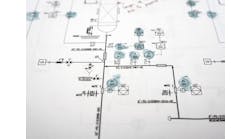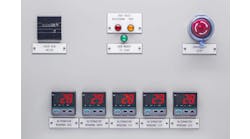This Control Talk column appeared in the October 2021 print edition of Control. To read more Control Talk columns click here or read the Control Talk blog here.
Read Part 1 of "The Concealed PID Revealed."
Greg: Last month, we introduced you to the motivation and signals for a proportional-integral-derivative (PID) controller to do what can be an incredible job of providing basic and advanced regulatory control. There is unfortunately a considerable lack of understanding of what the PID can do and should do, complicated by confusion from academia, suppliers and users not being on the same page. The key to spreading the beneficial knowledge gained over decades is to get the leading experts in industrial applications to document their knowledge, and develop consistent terminology and essential concise explanations of functionality in the ISA 5.9 PID Algorithms and Performance Technical Report. Here we begin to get to the heart of the matter by having one of the experts who wrote the section on PID Algorithms explain the informational objectives he sought to resolve and the resulting knowledge gained.
Peter Morgan, what are points of confusion that you resolved in the PID Algorithms section?
Peter: While the PID algorithm in its various forms has been the workhorse of virtually all closed-loop control applications for nearly a century, the fact that there's been no standard convention for naming each of the algorithm forms has led to confusion and sometimes heated debate, when the adopted form name suggests the property of the algorithm. A good example of the latter is the common use of the form name “non-interacting” for the parallel algorithm. This name, suggesting the behavior of the algorithm, for gain, reset and derivative parameter adjustments, rightly expresses the behavior of the algorithm from a time domain perspective, but not from a frequency domain perspective, when, if gain is adjusted, the phase shift across the controller changes at a given frequency, requiring compensating adjustment in reset and derivative parameters during the tuning process.
In my own experience, due to the inconsistency in the naming convention adopted by vendors, I was never confident about which form I was selecting, unless I was able to verify it by reference to the PID equation provided in vendor documentation. The only exception was the parallel form, when it's offered as an option, since it unambiguously defines the structure.
One of the earliest activities of the ISA 5.9 Committee was to survey members and review vendor documentation to determine the range of form names adopted by vendors and practitioners. This activity soon gave evidence to the bewildering variety of names used in describing the PID form offered by vendors or favored by users. For example, for the parallel algorithm alone, some of the names in common use are parallel, ideal parallel, non-interacting, independent, gain independent and independent gains form. ISA 5.9 establishes an unambiguous naming convention for the three PID position forms, namely: parallel, standard and series PID forms.
The report illustrates and distinguishes the characteristics of each PID form with reference to the frequency response characteristics. This approach is not common, but it's the most illustrative in my opinion of the characteristics of the PID algorithm, and provides the foundation for control loop tuning.
Benefitting from the collaboration of committee members with collectively many decades of experience and enquiry, the report shines light on many of the features of the PID algorithm not previously found in one reference document. Below are listed five of the key additional benefits the report is intended to provide.
- Adds to the understanding of common features. The standard brings together in one place a description of the common features such as output tracking, integral tracking, process variable (PV) tracking and feedforward, with typical applications described. As PV tracking is commonly misapplied, the standard provides guidance for its selection.
- Provides insight regarding the effect of sampling on PID loop performance. Since contemporary PID controllers are typically implemented digitally, the implications of sampling are discussed and recommendations made for selection of sampling interval (also known as execution interval). When early distributed digital control systems (DCSs) allowed for the implementation of only a small number of PID loops per controller with fixed sampling interval, a basis for reasoned selection of sampling interval was hardly required.
However, with contemporary control systems offering user configurable PID execution interval and the number of loops configurable only limited by processor capacity to execute the algorithms, some judgment is required in selecting the execution interval for each loop, so that the controller`s ability to complete all required tasks isn't compromised. The report illustrates the effect of sampling on PID loop behavior and provides practical guidance for the selection of PID execution interval based on loop target response times. - Demystifies digital implementation. The report provides practical guidance for the digital implementation of the PID algorithm. Although, this may be of passing interest to those implementing well-tried algorithms on a familiar platform, the report provides an uncommon and valuable resource for modelling realistic digital PID controllers.
- Adds to the understanding of provisions to prevent integral windup and the behavior and impact of specific implementations of anti-reset windup. Although contemporary control systems implement logic to prevent integral windup at the PID controller when output limits and (typically) external limits are reached, the output may leave the limit when there is a reversal in actuating error in one implementation, while in another it may leave the limit when the error is less than that obtained when the limit was reached. While all methods avoid any latency in action due to integral windup, it's important that the user recognize the behavior and its cause, so an alternative implementation or additional logic can be implemented to provide the desired result. The report describes the behavior for common implementations of PID and provides examples that can meet specific control objectives.
- Reintroduces integral action through filtered positive feedback as a practical and beneficial alternative to conventional PID implementations, especially when external reset feedback is applied. Integral action by the application of filtered positive feedback is a legacy of early pneumatic controllers that few vendors have sought to benefit from in contemporary digital control systems. The PID algorithm section of the report reintroduces the method, describing its characteristics and implementation, and the benefits with respect to the algorithm’s inherent property of preventing integral windup without additional logic. A variation of the implementation using external-reset feedback is noted to bring further benefit in accounting for external limits and lost motion. The report is expected to encourage the use of this implementation of PID when it's available as an option, and encourage system suppliers to offer the method as an option.
In general and to summarize, the report is expected to benefit system vendors, users and researchers in avoiding ambiguity in identifying PID form, in the understanding of common PID characteristics and available features, and (for the researcher in particular) in providing practical digital implementations that facilitate the modelling of real-world PID controllers for dynamic studies.
On a personal note, serving on the ISA 5.9 committee provided me with the opportunity to collaborate with a number of experienced, enthusiastic and, not least of all, generous practitioners in the field, an experience that's been inspirational and challenged some of my own ideas.
2-1 Limit your response to not exceed what people or systems can accomplish (output limits)
2-2 Don’t get stuck wound up from extreme situations (anti-reset windup)
2-3 Be ready to reverse direction as situation reverses direction (maximize proportional and derivative and minimize integral action)
2-4 Stop changing your response when projected response reaches goal (maximize proportional and derivative and minimize integral action)
2-5 Maximize your rate of response to a disturbing deviation to get through deadband and resolution limits faster and back to goal faster (maximize proportional and derivative and minimize integral action)
2-6 Limit the immediate response to a change in goal so as not to have to moderate your response to a disturbing deviation (use setpoint weight limits in two degrees of freedom structure)
2-7 Make your response rate faster to a faster disturbing deviation rate (maximize proportional and derivative and minimize integral action)
2-8 Proactively identify and provide timely correction of potential disturbances and their effect on achieving your goal (use feedforward and feedforward dynamic compensation)
2-9 Limit the rate of your requested response to not exceed the actual response rate capability of people and systems making the corrections (use external-reset feedback to prevent oscillations)
2-10 Make your requests for optimization of goals gradual and smooth to minimize disruption but your response fast and large for diligent prevention of bad scenarios (use external-reset feedback to provide a gradual approach to the optimum and fast getaway for abnormal conditions for valve position control, RCRA pH control, and compressor surge control)







